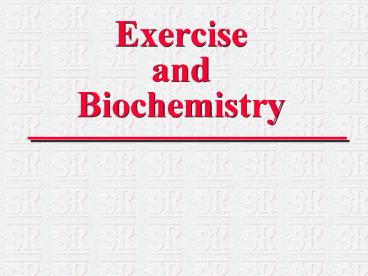Exercise and Biochemistry PowerPoint PPT Presentation
1 / 18
Title: Exercise and Biochemistry
1
Exerciseand Biochemistry
2
Energy Partitioning
- Onset of maximal exercise
- Demand for energy is high
- There is a lag time in reaching max. aerobic
energy production - Intensity of exercise
- Nature of onset of exercise
- Low intensity exercise, long duration
- Heart rates around 160 beats/min
- Energy provided largely by aerobic pathways
- Produce ATP at sufficient rates
- Greatest fuel economy
3
Energy Partitioning
- High intensity exercise of short duration
- Energy provided by anaerobic pathways
- Offers high rates of ATP
- Low fuel economy
- At any point in time
- Muscle fibers will be functioning aerobically and
anaerobically - Anaerobic pathway reliance increases as speeds
increase - Speeds greater than 8-10 m/s or 20 mph
- Back-up of substrates in mitochondria
- Not due to oxygen depletion
4
Energy Partitioning
- Main drive to recruit the anaerobic pathway
- Aerobic energy pathways are working at max, but
demand for ATP is still rising. - The use of anaerobic pathways result in
- Increase in blood lactate levels
- Anaerobic threshold
- Energy Partitioning
- Contribution of each energy pathway to the total
energy requirement for exercise.
5
Energy Partitioning
- Measurement of pathway utilization
- Estimated by measuring O2 uptake and CO2 and
lactate production at various speeds - Sprinters (2 furlongs or 400 m)
- Obtain approx. 60 of energy from anaerobic
- 40 aerobically
- Traveling abt 40 mph
- Middle distance runners (1 ½ miles, Derby)
- Approx. 80 aerobically
- And 20 anaerobically
- Start and finish of the race
- Endurance (100 miles at 10 mph)
- Approx. 96 aerobically
- And 4 anaerobically
6
Energy Partitioning
- Anaerobic energy production
- Normally begins around 150-180 beats/min
- Equivalent of a good or ¾ speed canter
- Initial appearance of lactic acid
- Factors affecting onset of anaerobic E production
- Unfit compared to a Fit horse
- High proportion of fast twitch high glycolyti
muscle fibers - Health problems
- Upper airway obstruction
- Cardiovascular disease
- Lower airway disease
- Pain, excitement, and type of warm-up exercise
- Time of feeding
- Environmental conditions
7
Energy Partitioning
- How can you tell what fuels are being used for
energy generation? - Respiratory exchange ratio (RER)
- Ratio of carbon dioxide production (Vco2,
liters/m) to oxygen consumption (Vo2, liters/m) - CHO RER is 1
- Fat RER is 0.7
- RER gt 1 indicates that some of the energy is
coming from anaerobic lactate acid prod.
8
Energy Partitioning
- RER can be used to determine response to
- Dietary manipulation
- RER 0.9 rest
- RER 0.9 typical hay/conc diet
- RER 0.75 high fat diet
- Exercise and training
- May reflect muscle fiber type composition
9
Energy Partitioning
- Size of the fuel stores
- How much fuel can a 500kg horse carry?
- Sum of fat, muscle and liver 230kg (500 lbs.)
- Muscle 200 kg (440 lbs)
- Liver 6.5 kg 14.3 lbs)
- Fat 25 kg (55 lbs)
- 95 of glycogen stores are in muscle
- 5 in liver
- 95 of the bodys fat is stored in adipose tissue
- 5 stored w/in the muscles
10
Energy Partitioning
- Approx. 10 times as much energy is stored as fat
compared w/ glycogen. - Fat is ideal for exercise where the body
requires - Slow release of energy
- Large energy reserve
- Training at low speeds and long durations
- Increases the number of enzymes involved in
oxidative phosphorylation
11
Energy Partitioning
- Galloping a fat horse
- Risk breakdown of musculoskeletal structures
- Make it sweat and lose body mass
- Use up muscle glycogen
- Give it an appetite
- Fat is less dense than muscle
- Muscle is 20 more dense
- Dieting and exercise shape change
12
Energy Partitioning
- Running out of energy
- Fatigue during exercise
- Never the result of depletion of fat
- Commonly due to depletion of muscular/liver
glycogen - Light headed/tired depletion of blood Glu and
liver glycogen - Muscle fatigue depletion of muscle glycogen
- Glycogen loading is not recommended
13
Energy Partitioning
- Workout schedules
- Maximal sprint or interval work more than 2 to 3
times a week or consecutive days - Will not allow glycogen stores to be replenished
by next bout - Glycogen breakdown
- Dependent on its concentration
- Breakdown is high w/ high concentrations
14
Exercise and Biochemistry
- Homeostasis
- Is the maintenance of a dynamic equilibrium in
the body. - Dynamic implies activity, energy, and work.
- Equilibrium refers to balance.
- The whole body is responsible for homeostasis.
15
Exercise and Biochemistry
- Steady-state
- Internal environment is unchanging while under
some stressor (exercise). - How is this done?
- Control Systems of the body
- Cellular control
- Regulation of protein synthesis, degradation,
energy production, maintenance of nutrient levels - Systemic control
- Pulmonary
- Gas exchange
- Cardiovascular
- Gas and nutrient transport
16
Exercise and Biochemistry
- Nature of the Control Systems
- Biological control system
- Receptor
- Integrating center
- Effector
- Stimulus or signal
- Negative feedback
17
Exercise and Biochemistry
- Example
- Regulation of body CO2
- Increased CO2 triggers receptor
- Sends information to integrating center
(Respiratory control center) to increase
breathing. - Effectors are respiratory muscles.
- Such changes will lower extracellular CO2 back to
normal conditions thereby re-establishing
homeostasis.
18
Exercise and Biochemistry
- Exercise
- A Test of Homeostatic Control
- Increased lactic acid and acidity
- Challenges acid-balance
- Increased O2 uptake and CO2 production
- Increases in ventilation
- Increases blood flow to working muscles

